Iron smelting and steel production represent one of the major sources of heavy metal pollution in the terrestrial ecosystem. The heavy metals eventually find their ways into the food chain and get accumulated into the bodies of living organisms where they have the capacity to cause different health havoc. This is in addition to the air pollutants such as SO2 , CO2, particulate matters etc. that emanate from the exhausts of the iron smelting activities.
Hence, iron smelting and steel production companies together with other similar industries by international law are supposed to be located far away from inhabitant areas and take relevant precautions to limit the extent at which they pollute the environment. Unfortunately, this is not always the case especially in the cases of developing countries where inadequate policies, government insincerity and corruption provides a fertile ground for the disregard of international practices in the location of industries.
The disregard for laws exposes the populace to the danger of heavy metal toxicity, cancer and other health related issues as a result of pollution. Most of these effects usually manifest themselves in the medium to long term and only take an enlightened mind to associate them with the industries around.
The curious case of Ife Iron and Steel
This company is not just located a few feet away from an interstate federal road but within less than a mile of inhabitant area. Several official complaints have been lodged to the government concerning the activities of the firm which sometimes leave a heavy plume of smoke covering the surrounding community during the day while creating a very heavy smog in the morning and even sometimes in the afternoon. Motorists have to put on their headlamps within a distance of about 500 meters while driving in front of the company.
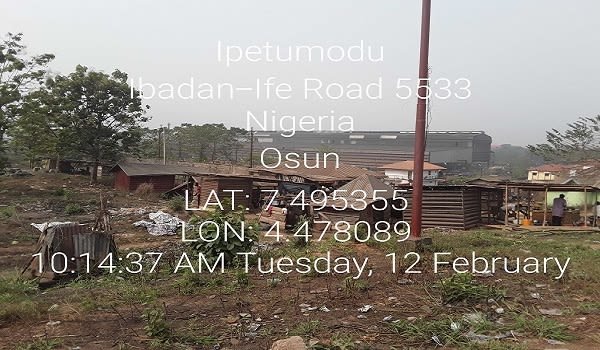
Geological location of Ife Iron and Steel.
Several organized protests have been carried out by the surrounding communities to call the attention of the authority of the firm and the government but none of these has yielded any positive results. In one pressing briefing, the company's PRO actually claimed that their operations is compatible with international guidelines. You can read one of the news concerning the activities of the company here
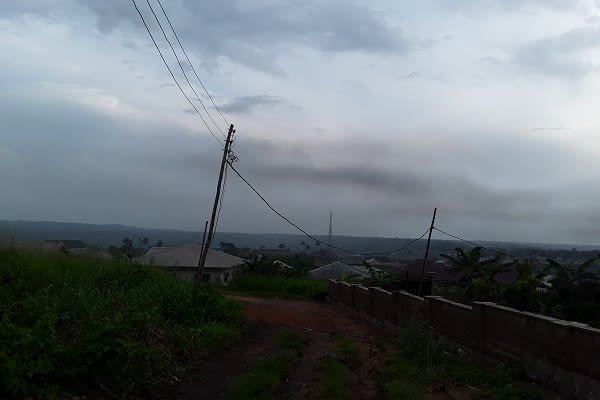
A residual plume of smoke emanating from Ife Iron and Steel Company (in the horizon). Image was taken in one of the communities about a mile from the company.
Update on my research
So, on Tuesday the 12th of February, myself and my colleague (@creativedee) together with some few selected students in my institution decided to proceed with sample collection at the research site. Due to the earlier knowledge that taking pictures of the Iron and Steel Company is often frown at by the security operatives of the company, we limited ourselves to taking pictures from outside.
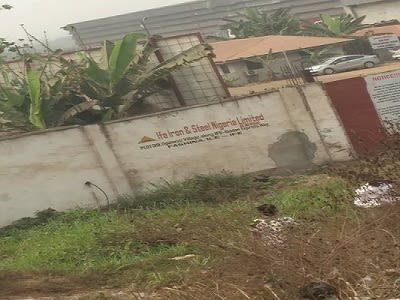 We proceeded to the vegetation adjoining the fence of the company where several outlets for effluent discharge from the company are located. It was a bit surprising to see some lands in this area under agricultural cultivation. If one is actually wondering how heavy metals get into the food chain, there is one of the answers. In addition, we also found fragments of cocoa plantation adjoining the fence of the company. Do cocoa seeds get analysed for heavy metals before being processed into other products? I wonder.
We proceeded to the vegetation adjoining the fence of the company where several outlets for effluent discharge from the company are located. It was a bit surprising to see some lands in this area under agricultural cultivation. If one is actually wondering how heavy metals get into the food chain, there is one of the answers. In addition, we also found fragments of cocoa plantation adjoining the fence of the company. Do cocoa seeds get analysed for heavy metals before being processed into other products? I wonder.
The fence of the Ife Iron and Steel Company showing the effluent discharing points
We eventually got to an area that looks like fragmented vegetation but suitable for study. Instead of setting up a 25 m by 25 m study plots as I wrote earlier in the tentative methodology, we opted for a transect method of sampling. Three 50 m transects that are 50 m apart were laid out starting from the fence of the company.
Laying out a transect line with the fence of Ife Iron and Steel as the starting point
Along each transect line and starting from the company's fence and moving further down, soil samples were collected for microbial analysis, bulk density analysis and soil biomass carbon, nitrogen and phosphorus analysis. The soil samples for microbial, biomass carbon, nitrogen and phosphorus analysis were collected into sterile ziplock bags and stored in cold chain. The samples for heavy metal and bulk density analysis were collected separately in small sample bags.
All the soil samples were collected using a 20cm soil auger except the samples collected for bulk density analysis which were collected using a 19cm by 5cm soil corer. Samples collected using soil auger were at 2 depths, the topsoils were first collected separately at 0-10cm depths while the sub-soils were collected at 10-20cm depths. Sampling points along each transect were 5 m apart culminating in a total of 10 sampling points along each transect and 30 sampling points in all.
The soil samples for heavy metal and bulk density analysis as at the time of writing this article are still being air-dried in the laboratory while those for microbial and biomass nutrient analysis are still being stored at low temperature to keep the microbes at a relatively constant load and prevent the conversion of the nutrients into another form respectively. Both analyses would be carried out in the coming days while plant species enumeration of the study area would still be carried out.
Thank you all for reading.
All images used are original images taken by me and my team.
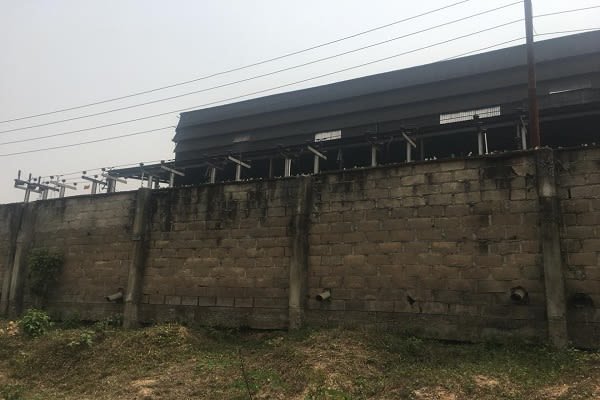
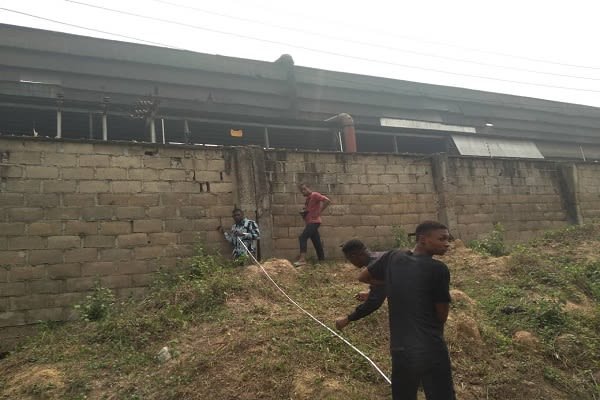
This post has been voted on by the SteemSTEM curation team and voting trail in collaboration with @utopian-io.
If you appreciate the work we are doing then consider voting both projects for witness by selecting stem.witness and utopian-io!
For additional information please join us on the SteemSTEM discord and to get to know the rest of the community!
Downvoting a post can decrease pending rewards and make it less visible. Common reasons:
Submit
The regulatory organization is a big joke in my country.
Downvoting a post can decrease pending rewards and make it less visible. Common reasons:
Submit
Hi @gentleshaid!
Your post was upvoted by Utopian.io in cooperation with @steemstem - supporting knowledge, innovation and technological advancement on the Steem Blockchain.
Contribute to Open Source with utopian.io
Learn how to contribute on our website and join the new open source economy.
Want to chat? Join the Utopian Community on Discord https://discord.gg/h52nFrV
Downvoting a post can decrease pending rewards and make it less visible. Common reasons:
Submit
This is great. Its awesome seeing you and your students doing this kind of research and the photos are a nice touch. I'm very excited to see what you find in the soil samples.
Downvoting a post can decrease pending rewards and make it less visible. Common reasons:
Submit